| Article ID | Journal | Published Year | Pages | File Type |
|---|---|---|---|---|
| 1710993 | Biosystems Engineering | 2015 | 14 Pages |
Abstract
Cereal grains are an important part of human diet; hence, there is a need to maintain high quality in these grains. Contaminants (foreign materials, dockage, and animal excreta) are the major impurities in cereal grains. A procedure was developed to differentiate these contaminants from wheat using near-infrared (NIR) hyperspectral imaging. Three experiments were conducted to identify the best combinations of spectral pre-processing technique and statistical classifier to classify contaminants represented by seven foreign material types (barley, canola, maize, flaxseed, oats, rye, and soybean); six dockage types (broken wheat kernels, buckwheat, chaff, wheat spikelets, stones, and wild oats); and two animal excreta types (deer and rabbit droppings) from Canada Western Red Spring (CWRS) wheat. The raw NIR reflectance spectra of these contaminants and wheat were collected in the NIR range (1000-1600Â nm). These spectra were processed using five spectral pre-processing techniques (first derivative, second derivative, Savitzky-Golay (SG) smoothing and differentiation, multiplicative scatter correction (MSC), and standard normal variate (SNV)) to reduce signal noises and improve the generalised capability of statistical classifiers. The raw and pre-processed data were classified using Support Vector Machines (SVM), Naïve Bayes (NB), and k-nearest neighbours (k-NN) classifiers. In each study, two-way classifications were conducted to understand the classification of each contaminant type from wheat and multi-way classifications were conducted to understand the classification of all contaminant types from wheat. Contaminants and wheat were classified with highest classification accuracy when spectral data were pre-processed using the SNV technique and classified using the k-NN classifier.
Related Topics
Physical Sciences and Engineering
Engineering
Control and Systems Engineering
Authors
Lankapalli Ravikanth, Chandra B. Singh, Digvir S. Jayas, Noel D.G. White,
